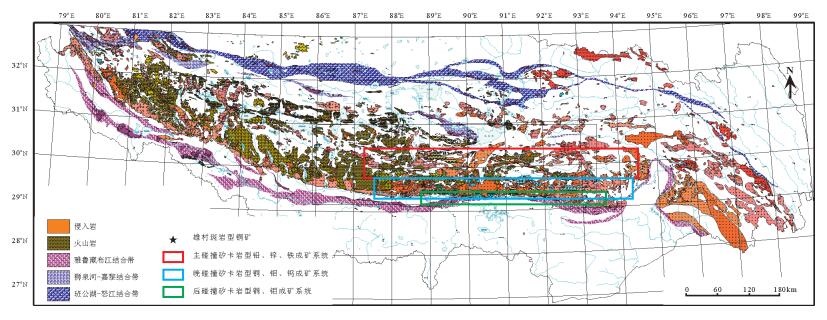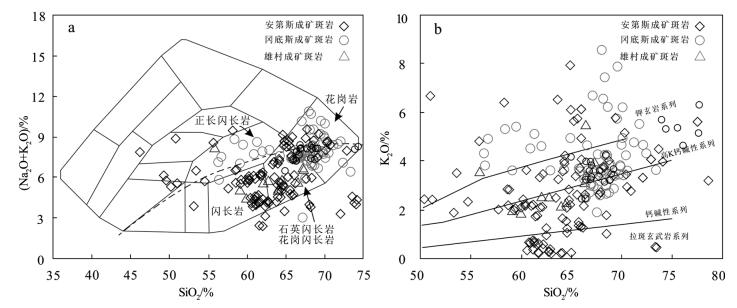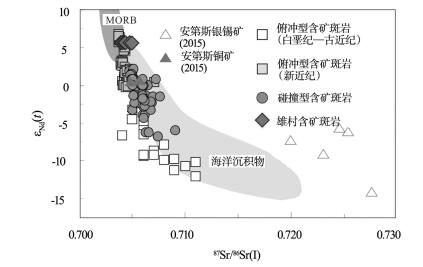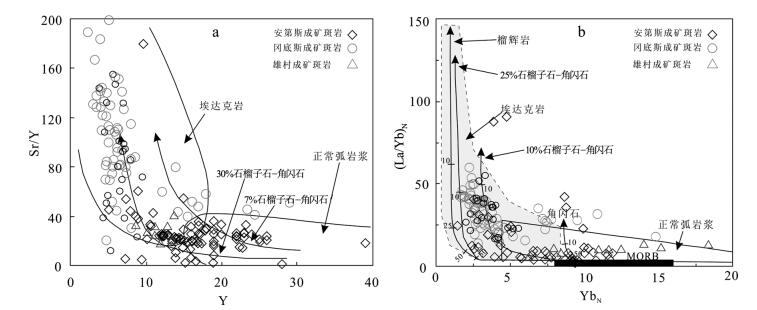Comparison of geological mineralogy and geochemical characteristics between ore-bearing porphyries of porphyry deposits in the Andean and the Gandise metallogenic belts
-
摘要:
在总结安第斯和冈底斯斑岩铜矿床地质矿物学特征的基础上,通过对2个成矿带与斑岩铜矿床有关的岩浆岩地球化学特征的对比分析,探讨了2种构造环境下形成的斑岩铜矿床含矿斑岩与成矿过程的异同点。安第斯成矿带的斑岩铜矿床形成于洋壳俯冲陆缘弧环境,成矿时代主要集中在始新世晚期-渐新世(43~31Ma)和中新世中期-上新世(12~4Ma),金属组合包括Cu-Mo和Cu-Au,含矿斑岩的SiO2含量变化范围较大,岩性从中性到酸性,以钙碱性-高钾钙碱性系列为主,少部分具有典型埃达克岩地球化学特征,而大多数安第斯含矿斑岩具有正常岛弧系列火山岩的地球化学特征。冈底斯成矿带斑岩铜矿床主要发育于陆-陆碰撞环境,成矿时代为中新世(20~12Ma),金属组合为Cu-Mo,缺乏Cu-Au组合,含矿斑岩岩性以酸性为主,且主要为高钾钙碱性-钾玄质系列岩浆岩,具有典型埃达克岩的地球化学特征。安第斯成矿带含矿斑岩的形成很可能是板片释放流体交代楔形地幔,经部分熔融与MASH过程的产物,并不是直接源于洋壳的部分熔融;而冈底斯成矿带含矿斑岩成因可能是早期洋壳多次俯冲形成俯冲增生弧,之后在陆陆碰撞过程中经历缩短加厚,与深部构造动力学机制发生变化时的部分熔融有关。
Abstract:In this paper, the authors analyzed and compared the geochemical characteristics of the magmatites related to porphyry copper deposits between the Andean and Gangdise metallogenic belts based on the summarizing of the geological mineralogical differences of both the ore-bearing porphyries and the mineralization mechanisms between the porphyry copper ores formed in two different tectonic backgrounds. The porphyry copper deposits in the Andean metallogenic belt were developed during the subduction process of oceanic crust, and they were mainly formed in the late Eocene-Oligocene (43~31Ma) and the middle Miocene-Pliocene (12~4Ma). Their metal combinations include Cu-Mo and Cu-Au. The components of SiO2 in the ore-baring porphyries vary in a large range, and the lithologies of these porphyries change from intermediate to acidic, dominated by the series of calcium alkaline-high potassium calcium alkaline rocks. Only a small part of the ore-bearing porphyries has typical adakite geochemical characteristics, whereas most of ore-bearing porphyries in the Andean metallogenic belt have the volcanic rock geochemical characteristics of normal arc series. The porphyry copper deposits in the Gangdise metallogenic belt were mainly developed during the continental collision process, and they were mainly formed in the Miocene (20~12Ma). Their metal combination is Cu-Mo with the lack of the combination of Cu-Au. The lithologies of ore-bearing poryphries are mainly acid, the poryphyries are dominated by magmatic rocks with high potassium calcium alkali, and the ore-bearing porphyries have typical adakite geochemical characteristics. The ore-bearing porphyries in the Andean metallogenic belt might have been formed during the partial melting process of the wedge mantle material metasomatized by the fluid which was released from the crust plate and the MASH procedure. They were not developed directly from the partial melted oceanic crust. The ore-bearing porphyries in the Gangdise metallogenic belt might have been formed during the partial melting process of the subduction accretion arc with the change of deep tectonic dynamic mechanism, which was caused by the multi-subduction of ocean crust and was shortened and thickened during the continental collision process.
-
Keywords:
- Andes /
- Gangdise /
- porphyry copper deposit /
- ore-bearing porphyry /
- geochemical characteristics
-
致谢: 对参与本文相关地质调查项目的所有人员表示诚挚的感谢。
-
图 1 中安第斯成矿省主要斑岩铜矿床分布[4]
Figure 1. Distribution of porphyry copper deposits in middle Andean metallogenic province
表 1 安第斯成矿带各斑岩铜矿床成矿期已发现的铜资源量①
Table 1 Porphyry copper resources discovered in the Andean metallogenic belt
围岩年龄 铜储量和资源量/104t 占已发现资源量的比例/% 晚中新世—早上新世 16600 28 中新世—上新世 2890 4.9 中新世中晚期 4700 7.9 中新世 410 0.7 始新世—渐新世 26900 45.4 古新世—始新世 6500 11 晚白垩世—中始新世 95 0.2 白垩纪 60 0.1 侏罗纪 900 1.5 二叠纪 200 0.3 合计 59255 100 表 2 安第斯与冈底斯斑岩铜矿床主要地质特征对比
Table 2 Comparison of main geological features of the porphyry copper deposits in Andes and Gangdise
成矿带类型 矿床 金属 含矿斑岩 岩石组合 蚀变矿物 时代/Ma 参考文献 安第斯成矿带 El Teniente 铜-钼-金 安山玢岩 安山岩、煌斑岩岩脉 黑云母、钠-钾长石、绿泥石、绢云母、绿帘石、磁铁矿、粘土矿物、石英、石膏、硬石膏、重晶石、电气石、碳酸盐矿物 4.8 [18] Chuquicamata 铜-钼-金 二长花岗斑岩 花岗闪长岩 黑云母、钾长石、钠长石、石英、絹云母、黄铁矿 33.6 [18] Rio Blanco-Los Bronces 铜-钼 石英二长斑岩、长石斑岩 安山岩、石英二长闪长岩、 石英、絹云母、黑云母、钾长石、钠长石、黄铁矿 5.4 [18-19] La Escondida 铜-钼-金 安山岩、石英闪长斑岩 流纹岩、石英二长岩、英安岩 高岭土化、絹云母化、明矾石化、钾长石化、斜长石化、绿泥石化、绿帘石化、黄铁矿 38 [18]③ Los Pelambres-El Pach 铜-钼 石英闪长斑岩 安山岩和细晶岩岩脉 黑云母、钾长石、石英、絹云母、粘土矿物 10 [18] Rosario 铜-钼 花岗闪长岩、石英二长斑岩 花岗闪长岩 黑云母、钠长石、磁铁矿、钾长石、黄铁矿、伊利石、绿泥石 34.1 [18] RadomiroTomic 铜-钼 花岗闪长岩 花岗闪长岩 钾长石、黑云母、石英、絹云母、黄铁矿 32.7 [18]④ La Granja 铜-钼-金 黑云母花岗闪长斑岩、角闪石花岗闪长斑岩、长石石英斑岩 安山岩、流纹岩、斑状闪长岩 絹云母、石英、黑云母、粘土矿物、绿泥石 10 [20]③-⑤ Escondida Norte 铜-钼 石英二长岩-花岗闪长斑岩 流纹岩; 石英二长岩(成矿后) 黑云母、绿泥石、絹云母、黄铁矿、硅化 39~36 [20] El Salvador 铜-钼-金 流纹英安岩、玄武岩 玄武岩、安山质熔岩、英安岩、玄武质安山岩 赤铁矿、方解石、绿泥石、钠长石、微斜长石、绿帘石、榍石、金红石、石英、絹云母 41 [18] Toki 铜 石英闪长岩、花岗闪长岩 闪长岩、二长闪长岩、花岗闪长岩、石英闪长岩、英安岩 黄铁矿、絹云母、绿泥石、绿帘石、硅化 39-36 [21-22] 冈底斯成矿带 雄村 铜±金-钼 角闪石英闪长玢岩 黑云母花岗闪长岩、斜长闪长玢岩、安山岩和煌斑岩 磁铁矿、石英、黑云母、絹云母、红柱石、石膏、绿泥石 183~177 [23] 驱龙 铜-钼 花岗闪长岩 二长花岗斑岩、闪长玢岩 钾长石、斜长石、黑云母、绿帘石、绿泥石、絹云母、石英、硬石膏 16.8 [24-25] 甲玛 铜-钼(-金) 二长花岗岩 花岗斑岩、闪长岩 石英、絹云母、角岩化、砂卡岩化 15 [24, 26]② 南木 铜-钼 花岗闪长岩、二长花岗岩 黑云母二长花岗岩、石英二长岩 钾长石、黑云母、絹云母、绿帘石、绿泥石、碳酸盐化 16.4 [24, 26]② 厅宫 铜-钼 石英二长花岗岩 花岗岩 磁铁矿、桂化、絹云母化 14.3 [27]② 冲江 铜-钼 二长花岗岩 花岗岩 黄铁矿、磁铁矿 15.6 [24, 28]② 白容 铜-钼 黑云二长花岗斑岩、英安斑岩 石英二长(闪长)岩、英云闪长岩 石英、长石、絹云母、石膏、方解石、绿泥石 12 [29] 邦浦 钼-铜 二长花岗斑岩 凝灰岩 黄铁矿、辉钼矿、黄铜矿、方铅矿、石英、钾长石、斜长石、絹云母、方解石、绿泥石 14 [30-31] 表 3 冈底斯成矿带成矿斑岩样品主要地球化学特征测定结果
Table 3 Major element geochemical analyses of the ore-bearing porphyries in the Gangdise metallogeinc belt
% 样品号 SiO2 AI2O3 CaO Fe2O3 FeO K2O MgO MnO Na2O P2O5 TiO2 TFe2O3 NaOK2O K2O/Na2O A/NK A/CNK Mg# NM1501 77.6 11.73 0.46 0.96 0.11 5.17 0.11 0.02 2.97 0.01 0.13 1.08 8.104 1.740741 1.117555 1.03494 3.535316 NM1502 66 15.89 2.86 2.94 0.32 2.47 1.39 0.03 4.82 0.19 0.48 3.292 7.29 0.512448 1.497659 1.004477 30.53952 NM1505 66.39 15.8 2.48 1.82 1.33 2.5 1.6 0.03 4.74 0.18 0.48 3.283 7.24 0.527426 1.503211 1.051373 35.95485 NM1508 69.16 14.93 1.19 2.06 0.18 3.7 0.97 0.01 4.47 0.14 0.34 2.258 8.17 0.82774 1.313247 1.102963 23.56176 NM1511 66.42 14.08 2.18 2.79 1.47 3.26 1.94 0.03 4.01 0.28 0.41 4.407 7.27 0.812968 1.389308 0.998209 38.843 NM1512 68.92 14.82 1.8 1.51 1.19 3.49 0.8 0.02 4.68 0.1 0.27 2.819 8.17 0.745726 1.290224 1.003729 20.2616 BR02 66.89 14.89 1.97 2.16 0.51 3.28 0.91 0.04 4.85 0.12 0.34 2.721 8.13 0.676289 1.290428 0.984372 23.24096 BR03 66.43 14.99 2.96 2.33 0.83 4.01 1.34 0.04 3.95 0.19 0.45 3.243 7.96 1.01519 1.38161 0.922967 30.9119 BR04 66.75 14.81 3.09 2.53 0.75 3.61 1.41 0.05 4.08 0.19 0.46 3.355 7.69 0.884804 1.393293 0.910953 32.65725 BR05 66.98 15.65 2.67 2.16 0.75 3.37 1.1 0.05 4.82 0.22 0.55 2.985 8.19 0.69917 1.350712 0.951385 27.53127 TG01 75.51 12.71 0.36 0.84 0.25 5.39 0.32 0.01 3.08 0.05 0.22 1.115 8.47 1.75 1.164365 1.098385 7.629514 TG02 66.98 14.83 2.17 2.03 0.09 3.85 1.12 0.05 4.31 0.16 0.39 3.02 8.16 0.893271 1.316081 0.974324 24.7885 TG03 77.67 11.1 0.12 0.63 0.4 6.33 0.11 0.01 1.95 0.03 0.14 1.07 8.28 3.246154 1.101541 1.078156 2.399426 TG07 67.78 14.94 2.21 2.87 0.25 3.63 0.93 0.08 4.54 0.13 0.39 3.145 8.17 0.799559 1.309611 0.968035 16.6694 JM1512 68.27 14.63 2.47 2.27 0.11 3.17 0.83 0.05 4.27 0.13 0.34 2.391 7.44 0.742389 1.398043 0.977709 17.5364 JM1513 68.78 14.43 2.56 1.3 1.04 3.24 0.85 0.04 4.09 0.12 0.35 2.444 7.33 0.792176 1.408567 0.967981 28.20625 Zk2412350 66.88 14.26 2.38 2.27 0.83 4 1.26 0.04 4.43 0.17 0.41 3.183 8.43 0.902935 1.226299 0.893288 28.46475 Zk2412368 68.4 14.28 1.77 1.15 1.4 4.28 1.26 0.03 4.14 0.16 0.4 2.69 8.42 1.033816 1.246593 0.972808 25.46758 Zk2413423 64.94 14.01 3.13 2.21 0.54 4.19 1.2 0.02 2.32 0.16 0.4 2.804 6.51 1.806034 1.675162 0.996129 23.92736 Zk2414402 74.36 13.1 0.47 0.83 0.32 5.34 0.34 0.01 2.96 0.13 0.23 1.182 8.3 1.804054 1.228415 1.137131 11.6702 Zk2415664 81.2 9.39 0.18 0.07 0.4 5.7 0.25 0 1.23 0.07 0.17 0.51 6.93 4.634146 1.143915 1.099981 7.078907 Zk2415684 73.93 12.4 1.15 0.89 0.32 5.72 0.56 0.01 2.39 0.09 0.24 1.242 8.11 2.393305 1.223031 1.01362 14.32496 Zk2415874 76.07 11.84 0.77 1.21 0.25 4.66 0.51 0.03 2.92 0.09 0.25 1.485 7.58 1.595890 1.2007545 1.0512328 11.601856 表 4 安第斯成矿带成矿斑岩样品主量、微量和稀土元素测定结果
Table 4 Major, trace and rare earth elements analyses of ore-bearing porphyry samples in the Andean metallogenic belt
样品号 Ⅱ-3 Ⅲ-4 Ⅲ-5 Ⅳ-2 Ⅳ-3 Ⅳ-6 SiO2 68.26 74.05 72.07 77.53 72.86 66.02 Al2O3 17.38 15.79 16.28 11.33 13.87 17.28 CaO 0.07 0.12 0.04 0.08 1.68 0.19 Fe2O3 2.46 0.28 1.39 1.21 1.10 3.23 FeO 0.90 0.68 0.47 0.25 0.61 0.32 K2O 3.73 3.97 3.31 5.59 4.04 6.12 MgO 0.83 0.39 0.39 0.30 0.53 1.00 MnO 0.05 0.01 0.01 0.11 0.08 0.04 Na2O 0.08 < 0.01 < 0.01 1.11 3.94 0.07 P2O5 0.17 0.11 0.06 0.02 0.06 0.02 TiO2 0.77 0.55 0.48 0.16 0.19 0.31 CO2 0.34 0.34 0.00 0.00 0.17 0.52 H2O + 4.08 2.82 3.92 1.14 0.46 2.94 烧失量 4.08 2.91 4.18 1.36 0.40 3.36 Li 206 37.9 59.2 15.5 42.5 29.9 Be 3.74 4.56 5.53 0.69 3.22 2.38 Cr 25.7 26.0 25.1 5.82 7.89 3.50 Mn 407 79.2 80.6 891 632 299 Co 0.49 0.48 1.92 10.9 3.14 1.04 Ni 9.47 1.24 9.61 2.83 5.40 1.20 Cu 11.1 19.2 206 2400 92.7 4447 Zn 79.5 9.38 19.6 44.4 23.6 21.6 Ga 16.9 34.7 42.1 12.1 16.3 35.8 Rb 384 418 357 179 226 249 Sr 19.3 208 76.2 39.4 234 31.6 Mo 1.38 2.27 1.70 1.30 1.18 189 Cd < 0.05 < 0.05 < 0.05 0.37 < 0.05 1.11 In 0.61 0.31 0.43 < 0.05 < 0.05 0.19 Cs 30.1 12.0 23.0 1.91 19.5 2.22 Ba 218 94.2 56.0 948 302 289 Tl 3.33 2.18 2.01 0.70 0.52 0.78 Pb 878 15.8 15.3 6.94 13.2 2.23 Bi 39.1 0.38 17.8 0.24 0.07 1.73 Th 18.7 33.8 32.0 7.60 29.2 4.27 U 4.57 8.18 7.83 1.42 12.0 2.78 Nb 27.3 36.4 34.7 7.07 8.86 7.59 Ta 2.10 2.46 2.33 0.56 0.79 0.63 Zr 210 288 232 147 62.6 109 Hf 5.75 7.34 6.34 4.37 2.99 3.42 Sn 36.3 35.2 30.5 2.44 1.07 4.66 Sb 25.4 30.1 40.0 0.58 0.60 0.44 Ti 3989 3212 2923 900 1229 1787 W 2.89 4.79 3.56 0.60 0.43 33.0 As 34.6 1.44 29.8 1.62 1.93 23.9 V 57.1 48.4 41.5 9.00 21.8 76.0 La 56.8 88.6 76.6 30.5 17.8 30.8 Ce 111 160 145 56.3 28.4 56.8 Pr 13.2 18.4 16.0 6.47 2.83 6.19 Nd 49.7 67.7 53.9 23.5 10.1 21.3 Sm 7.53 9.97 8.36 5.25 1.93 3.47 Eu 1.00 1.69 1.56 0.95 0.39 0.57 Gd 4.54 5.87 5.45 3.39 1.12 1.84 Tb 0.68 0.73 0.67 0.55 0.16 0.27 Dy 3.42 3.53 3.34 3.12 0.93 1.38 Ho 0.63 0.61 0.57 0.59 0.18 0.26 Er 1.60 1.52 1.52 1.78 0.55 0.74 Tm 0.24 0.22 0.23 0.26 0.09 0.12 Yb 1.69 1.48 1.50 1.70 0.71 0.87 Lu 0.28 0.22 0.22 0.28 0.14 0.14 Sc 8.62 6.92 6.60 3.02 2.51 4.64 Y 15.3 15.0 14.0 16.7 5.23 7.34 注:主量元素含量单位为%,微量和稀土元素为10-6 -
芮宗瑶, 李光明, 张立生, 等.西藏斑岩铜矿对重大地质事件的响应[J].地学前缘, 2004, 11(1):145-152. 芮宗瑶, 侯增谦, 李光明, 等.冈底斯斑岩铜矿成矿模式[J].地质论评, 2006, 52:459-466. doi: 10.3321/j.issn:0371-5736.2006.04.004 杨志明, 侯增谦, 江迎飞, 等.西藏驱龙矿区早侏罗世斑岩的Sr-NdPb及锆石Hf同位素研究[J].岩石学报, 2011, 27(7):2003-2010. 卢民杰, 朱小三, 郭维民.南美安第斯地区成矿区带划分探讨[J].矿床地质, 2016, 35(5):1073-1083. http://www.doc88.com/p-1791426469326.html Moreno T, Gibbons W.The geology of Chile[M]. London:Geological Society of London.2007:211-232.
Singer D A, Berger V I, Menzie W D, et al.Porphyry copper deposit density[J]. Economic Geology, 2005, 100:491-514. doi: 10.2113/gsecongeo.100.3.491
Sillitoe R H.A plate tectonic model for the origin of porphyry copper deposits[J]. Economic Geology, 1972, 67:184-197. doi: 10.2113/gsecongeo.67.2.184
侯增谦, 曲晓明, 黄卫, 等.冈底斯斑岩铜矿成矿带有望成为西藏第二条"玉龙"铜矿带[J].中国地质, 2001, 28(10):27-30. doi: 10.3969/j.issn.1000-3657.2001.10.005 侯增谦, 高永丰, 孟祥金, 等.西藏冈底斯中新世斑岩铜矿带:埃达克质斑岩成因与构造控制[J].岩石学报, 2004, 20(2):239-248. 曲晓明, 侯增谦, 黄卫.冈底斯斑岩铜矿(化)带:西藏的第二条玉龙铜矿带?[J].矿床地质, 2001, 20:355-366. doi: 10.3969/j.issn.0258-7106.2001.04.009 Chung S L, Chu M F, Ji J Q, et al.The nature and timing of crustal thickening in Southern Tibet[J]. Tectonophysics, 2009, 477:36-48. doi: 10.1016/j.tecto.2009.08.008
Dong G, Mo X, Zhao Z, et al.Geochronologic constraints on the magmatic underplating of the Gangdese Belt in the India-Eurasia collision:evidence of SHRIMP Ⅱ zircon U-P bdating[J]. Acta Geologica Sinica, 2005, 79:787-794. doi: 10.1111/acgs.2005.79.issue-6
侯增谦, 杨竹森, 徐文艺, 等.青藏高原碰撞造山带:Ⅰ.主碰撞造山成矿作用[J].矿床地质, 2006, 25:337-358. doi: 10.3969/j.issn.0258-7106.2006.04.001 侯增谦, 潘桂棠, 王安建, 等.青藏高原碰撞造山带:Ⅱ.晚碰撞转换成矿作用[J].矿床地质.2006, 25(5):521-543. http://industry.wanfangdata.com.cn/dl/Detail/Periodical?id=Periodical_kcdz200605001 侯增谦, 曲晓明, 杨竹森, 等.青藏高原碰撞造山带:Ⅲ.后碰撞伸展成矿作用[J].矿床地质, 2006, 25(6):629-651. http://industry.wanfangdata.com.cn/yj/Detail/Periodical?id=Periodical_kcdz200606001 杨志明, 侯增谦, 宋玉财, 等.西藏驱龙超大型斑岩铜矿床:地质、蚀变与矿化[J].矿床地质, 2008, 27:279-318. doi: 10.3969/j.issn.0258-7106.2008.03.002 孟祥金, 侯增谦, 高永丰, 等.碰撞造山型斑岩铜矿蚀变分带模式——以西藏冈底斯斑岩铜矿带为例[J].地学前缘, 2004, 11(1):201-214. https://www.wenkuxiazai.com/doc/b69c7a0f25c52cc58ad6be4d.html Camus F.The Andean porphyry systems[M]. University of Tasmania, Centre for Ore Deposit Research Special Publication.2002, 4:5-22.
Deckart K, Silva W, Spröhnle C, et al.Timing and duration of hydrothermal activity at the Los Bronces porphyry cluster:an update[J]. Mineralium Deposita, 2014, 49(5):535-546. doi: 10.1007/s00126-014-0512-9
Schwartz M O.The porphyry copper deposit at La Granja, Peru[J]. Economic Geology, 1982, 77:482-487. doi: 10.2113/gsecongeo.77.2.482
Camus F.The Andean porphyry systems[C]//Porter T M.Super porphyry copper and gold deposits:A global perspective.Linden Park, South Australia, Porter Geo Consultancy Publishing, 2005:1-26.
Barra F, Alcota H, Rivera S, et al.Timing and formation of porphyry Cu-Mo mineralization in the Chuquicamata district, northern Chile:new constraints from the Toki cluster[J]. Mineralium Deposita, 2013, 48(5):629-651. doi: 10.1007/s00126-012-0452-1
郎兴海, 唐菊兴, 李志军, 等.西藏冈底斯斑岩铜矿带雄村矿区侏罗纪成矿作用:来自锆石U-Pb和辉钼矿Re-Os年龄的证据[J].矿物学报, 2013, S2:328. Hou Z Q, Gao Y F, Qu X M, et al.Origin of adakiticintrusives generated during mid-Miocene east-west extension in southern Tibet[J]. Earth and Planetary Science Letters, 2004, 220:139-155. doi: 10.1016/S0012-821X(04)00007-X
Yang Z M, Hou Z Q, White N C, et al.Geology of the post-collisional porphyry copper-molybdenum deposit at Qulong, Tibet[J]. Ore Geology Review, 2009, 36:133-159. doi: 10.1016/j.oregeorev.2009.03.003
Chung S L, Liu D, Ji J, et al.Adakites from continental collision zones:melting of thickened lower crust beneath southern Tibet[J]. Geology, 2003, 31:1021-1024. doi: 10.1130/G19796.1
Xu W C, Zhang H F, Guo L, et al.Miocene high Sr/Y magmatism, south Tibet:Product of partial melting of subducted Indian continental crust and its tectonic implication[J]. Lithos, 2010, 114:293-306. doi: 10.1016/j.lithos.2009.09.005
郑有业, 高顺宝, 程力军, 等.西藏冲江大型斑岩铜(钼金)矿床的发现及意义[J].中国地质大学学报(地球科学版), 2004, 29(3):333-339. 周维德, 张正伟, 袁盛朝, 等.西藏尼木县白容斑岩型铜钼矿床特征及成矿期次[J].矿物岩石地球化学通报, 2014, 33(2):177-184. 周玉, 温春齐, 周雄, 等.西藏邦浦钼铜多金属矿床稀土元素特征[J].矿物学报, 2009, 增刊:363-364. 周雄, 温春齐, 费光春, 等.西藏邦铺斑岩型钼矿床二长花岗斑岩地球化学特征及构造意义[J].矿物岩石, 2010, 30(4):48-54. 杨志明. 西藏驱龙超大型斑岩铜矿床——岩浆作用及矿床成因[D]. 中国地质科学院博士学位论文, 2008: 1-145. Mo X X, Dong G C, Zhao Z D, et al.Timing of magma mixing in Gangdise magmatic belt during the India-Asia collision:zirconSHIRMP U-Pb dating[J]. Acta Geologica Sinica, 2005, 79(1):66-76. doi: 10.1111/acgs.2005.79.issue-1
赵志丹, 莫宣学, Nomade S, 等.青藏高原拉萨地块碰撞后超钾质岩石的时空分布及其意义[J].岩石学报, 2006, 22:787-794. https://www.wenkuxiazai.com/doc/7f63444569eae009581bec77-3.html Gao Y F, Hou Z Q, Wei R H.Post-collisional adakitic porphyries in Tibet:Geochemical and Sr-Nd-Pb isotopic constrains on partial melting of oceanic lithosphere and crust-mantle interaction[J]. Acta Geologica Sinica, 2003, 77:123-135.
Richards P J, Kerrich R.Adakite-like rocks:their diverse origins and questionable role in metallogenesis[J]. Economic Geology, 2007, 102(4):537-576. doi: 10.2113/gsecongeo.102.4.537
Qu X M, Hou Z Q, Li Y G.Melt components derived from a subducted slab in late orogenic ore-bearing porphyries in the Gangdese copper belt, southern Tibetan plateau[J]. Lithos, 2004, 74:131-148. doi: 10.1016/j.lithos.2004.01.003
Guo Z F, Wilson M, Liu J Q.Post-collisional adakites in south Tibet:Products of partial melting of subduction-modified lower crust[J]. Lithos, 2007, 96:205-224. doi: 10.1016/j.lithos.2006.09.011
Gao Y F, Hou Z Q, Kamber B S, et al.Adakite-like porphyries from the southern Tibetan continental collision zones:evidence for slab meltmetasomatism[J]. Contribution to Mineral Petrology, 2007, 153:105-120. doi: 10.1007/s00410-006-0137-9
Willett S D, Beaumont C.Subduction of Asian lithospheric mantle beneath Tibet inferred from models of continental collison[J]. Nature, 1994, 369:642-645. doi: 10.1038/369642a0
Hou Z Q, Zhang H R, Pan X F, et al.Porphyry Cu(-Mo-Au) deposits related to melting of thickened mafic lower crust:Examples from the eastern Tethyanmetallogenic domain[J]. Ore Geology Reviews, 2011, 39:21-45. doi: 10.1016/j.oregeorev.2010.09.002



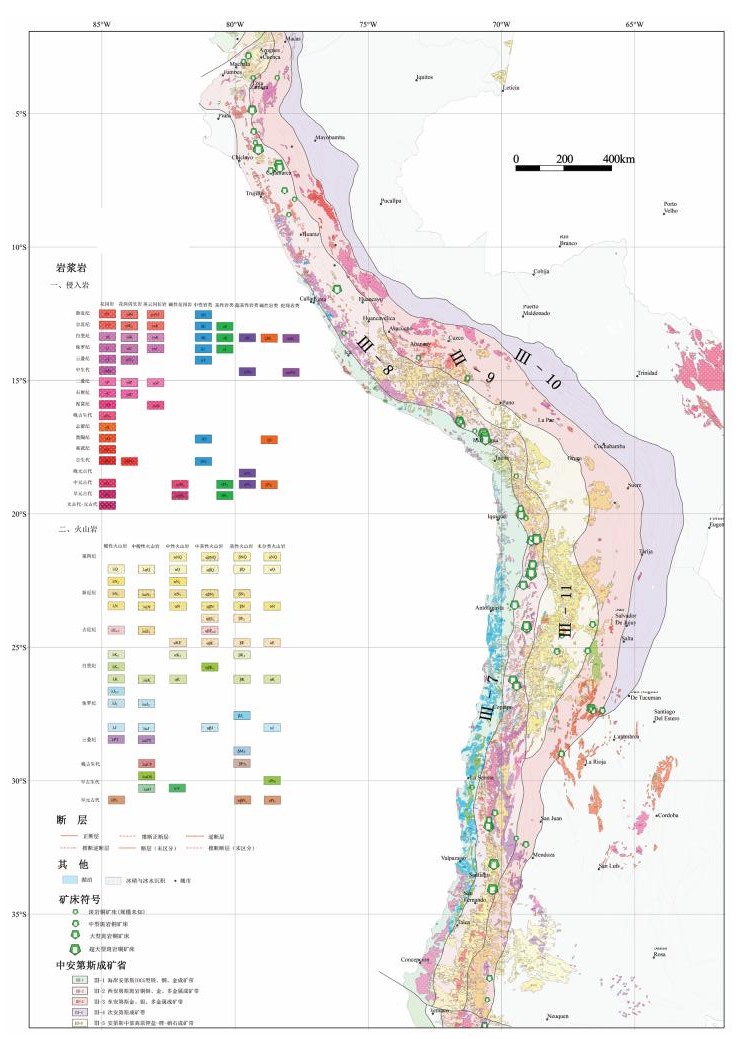
 下载:
下载:
